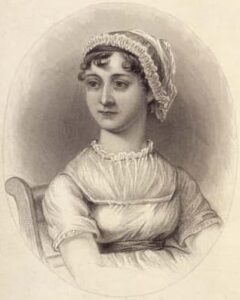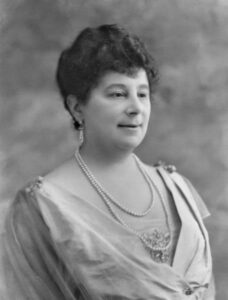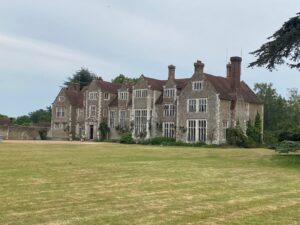•
(Caution: Contains spoilers for episodes: S10E07: They Seek Him Here, & S19E05: Death by Persuasion)
Diesen Beitrag gibt es auch auf Deutsch.
•
The idyllic landscape of Midsomer County is well known. No wonder Jane Austen and Baroness Emma Orczy, two famous writers, are said to have stayed here. Or is that just a story?
Competition for authenticity

The Gorgeous Georgians re-enactment at Whitcombe Grange Hall has to be interrupted because one of the Regency lovers has been murdered in the nearby woods – journalist Samantha Berry.
John Barnaby and Jamie Winter interview the house owners, Kitty and James Oswood. Kitty Oswood answers the question of what kind of event is taking place: It’s just a re-enactment in honour of Jane Austen’s visit to Whitcombe Grange Hall in 1801.
Gemma Christie, who lives in the village, sees it differently. She runs the Jane Austen Peace Centre, a kind of museum. In a small outbuilding – ‘The Jane Austen Tea Room’ is emblazoned on the outside of the building – there are several rooms full of Regency furniture. Every centimetre seems to have been utilised. Countless books are also lined up along the walls.
After introducing herself as a qualified historian and Jane Austen expert, she tells John Barnaby that Jane Austen actually came here in 1801, where the tearoom now stands. And did not spend the night in the manor house.
Jane Austen at Whitcombe Grange?
Whether Jane Austen actually stayed at Whitcombe Grange – in the Hall or in the village – is not really clear. Did Gemma Christie simply lie about her education in order to gain a better reputation and win the competition against Oswood’s ‘play’? Or is Jane Austen’s visit also part of the swindle?
Let’s take a look at Jane Austen’s life: born in 1775, she was taught by a relative in Oxford in 1783 and attended the Reading Ladies Boarding School from 1785 to 1786. She also visited relatives in Kintbury, Berkshire, the hometown of her mother Cassandra.
Before 1801, the family lived in Steventon, between Reading and Southampton and a good 10 miles or 20 kilometres south of the Berkshire border. For the first 26 years of her life, this was only a day’s journey away, so it is quite possible – provided that Midsomer County is equated with those counties where the shooting mostly takes place: Oxfordshire, Berkshire and Buckinghamshire.
Film Locations
Turville, the location of Gemma Christie’s museum and tearooms, is in Buckinghamshire. 22 miles to her home in Steventon, 14 miles to her boarding school, 20 miles to her mother’s home in Kintbury – in the 1800s a coach travelled at five miles an hour.
The village of Turville was inhabited in Anglo-Saxon times. Apart from the two manor houses already mentioned, the village made history through the Sleeping Girl of Turville. Exactly 70 years after Jane Austen’s supposed visit, the girl, Ellen Sadler, fell into a comatose sleep from which she could not be awakened. She became a tourist attraction, earning money for the family. After nine years, she awoke suddenly and, apart from a few minor physical consequences, lived a longer life. But there is no trace of any reference to Jane Austen.
The manor house was filmed 16 miles (25 km) away in Oxfordshire, in Wheatley near Oxford to be precise. Shotover Park, a Grade-I-listed building, is home to an 18th-century manor house, a park and a lake. But again… no connection to Jane Austen.
Lord Fitzgibbon – the archetype of a hero?
Superman, Batman, Spiderman, Zorro… the list of superheroes who do not reveal their identity is long. They are all based on the idea of Baroness Orczy and the Scarlet Pimpernel. A chivalrous, gallant Englishman called Sir Percy Blakeney, who, in disguise, saves aristocrats from the guillotine. On the one hand, a rich buffoon, on the other, a master swordsman, clever disguiser and escape artist.
With one distinguishing mark: A Scarlet Pimpernel.
Neville Hayward is pacing back and forth in the living room. He has a pad of paper in his hand and is writing something down. He speaks softly and incoherently to himself. His sister-in-law, Gwen Morrison, is doing tarot readings and is visibly annoyed by his movements and agitation. But he doesn’t notice because he is just very pleased with his wording.
Not so Gwen Morrison, who has been living with Neville since the death of her husband Ted. She sighs and rolls her eyes. She does not like it when he mentions that Baroness Orczy, author of the famous book ‘The Scarlet Pimpernel’, lived at Midsomer Magna Manor and that the character of Sir Percy Blakeney is based on the then landlord of Midsomer Magna, Fitzgibbon.
A defender of the aristocracy

Unfortunately, we learn little about Lord Fitzgibbon in the episode, and cannot compare the man with the novel character. But what about the fact that Baroness Orczy was in Midsomer Magna just after the turn of the century? Or rather, Loseley Park, Guildford, Surrey. (Yes, this is where the famous boxing match between Sayers and Heenan took place on the Farquaharson estate in 1860… or did it not?).
Emma ‘Emmuska’ Orczy spent her early years in Hungary as the daughter of a baron. Her family fled with her across Europe – Brussels, Budapest, Paris – during the uprising against the aristocracy, settling in England twelve years later in 1880. Throughout her life she believed in the supremacy of the aristocracy, imperialism and militarism. All these elements came together in her play about the Scarlet Pimpernel, which premiered in Nottingham in 1903.
Baroness Orczy came up with the idea for Sir Blakeney after testifying in Paris, where she had been with her husband, Henry George Montagu MacLean Barstow, shortly after the turn of the century. She is said to have written the play in just five weeks.
The Scarlet Pimpernel was originally a novel, but no publisher would print it, so a friend, an actor, introduced her to the acting team of Fred Terry and Julia Neilson, who were looking for a new romantic drama. So the Baroness rewrote her play as a play.
The Unknown Hero was born

Although the play was not a great success in Nottingham, it opened at the New Theatre in London on 5 January 1905 and proved very, very popular. So popular, in fact, that Orczy was able to sell her novel. This became an instant success as the rave reviews of the play brought Orczy many more readers in Britain and the rest of the world. The novel became a bestseller and a new kind of hero was born.
The story is set in England in 1792: Sir Percy Blakeney has formed the League of Scarlet Pimpernel: 19 selected men – all English aristocrats – who know his secret identity. His opponent was the citizen Chauvelin, sent to England by Jacobin France. The Scarlet Pimpernel saved several English lords and earls from the guillotine, naturally earning the resentment of the Jacobins and their supporters.
Fun fact: I first heard about the Scarlet Pimpernel in the episode ‘Nob and Nobility’ in the third series of Blackadder. In the pub, Edward expresses his support for the French Revolution and Liberty, Equality, Fraternity – and doubts the existence of the Scarlet Pimpernel. Tim McInnerny, who is always Percy in the series, plays an alter ego of the Scarlet Pimpernel in this episode. Fans of Blackadder will probably have guessed how this is going to end up.
They seek him here

The episode title is a quote from the novel. The full passage is: “They’re looking for him here, they’re looking for him there. The French are looking for him everywhere. Is he in heaven or in hell? That damned elusive Pimpernel”.
But where was Baroness Orczy? She lived in London, so it may well be that she once made a trip to Surrey. Loseley Park was built in the 16th century, partly with stones from Waverley Abbey after its Dissolution. By the time of the Domesday Book there was a building called Losele, owned by Torald (Thorold).
Orczy was so successful that she could afford a house in Monte Carlo. She also retreated here in exile when the Second World War reached England. She did not return to her beloved London, but to Oxfordshire. It was not Guildford, where Loseley Park stands, but Henley-on-Thames. And thus the location of ten episodes of Midsomer Murders, and 31 miles (50 km) from Loseley Park. But The Scarlet Pimpernel had already been written.
Occasional embellishment of the story
And really, it doesn’t matter, because …. do you remember the dialogue between Neville Hayward and Gwen Morrison? She dislikes the mention that Baroness Orczy lived at Midsomer Magna Manor and that Lord Fitzgibbon was her model for Sir Percy Blakeney.
And with good reason: it’s not true. But he doesn’t care, because it’s all about publicity. The end justifies the means. Isn’t that typical?
Read more about Midsomer Murders & History
The Chronology of Midsomer County by Year or by Episodes
Deep Dives into Midsomer & History
This is an independent, non-commercial project. I am not connected to Bentley Productions, ITV or the actors.

Literature
- Dugan, Sally: Baroness Orczy’s The Scarlet Pimpernel. A Publishing History. Abingdon 2012.
- Jane Austen Centre: Down the Kennet and Avon Canal with Jane Austen. In: Jane Austen Centre (10/01/2000).
- NN: Letters of Jane Austen. Brabourne Edition. Letters to her sister Cassandra Austen, 1801. In: The Republic of Pemberley. URL: https://pemberley.com/janeinfo/brablet5.html
- NN: Parishes: Turville. In: William Page (Ed.): A History of the County of Buckingham. Volume 3. P. 101-105.
- Royston, Peter: A brief biography of Baroness Orczy, the creator of the Scarlet Pimpernel. In: Guide Write.
First published on MidsomerMurdersHistory.org on 8 February 2024.
Updated on 3 August 2025.


3 thoughts on “Jane Austen & Baroness Orczy in Midsomer County”